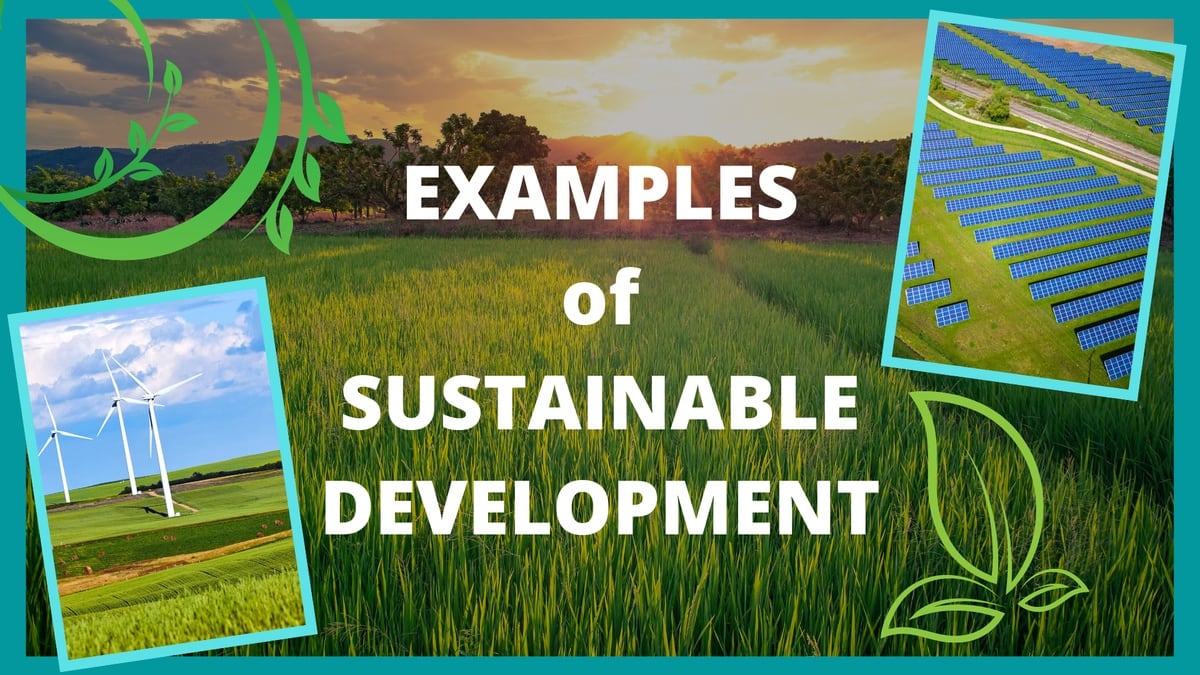For a long time, we suffered from the environmental and social problems caused by wild economic development and the pursuit of profit as the only goal. However, during the last decade, things started to change and today we can find many examples of sustainable development around us. However, what is sustainable development?
Sustainable development means “meeting the needs of the present generation without compromising the ability of future generations to meet their needs” (Brundtland 1987).
Sustainability is achieved when all the 3 pillars of sustainability (triple bottom line) are taken care of at the same time. This happens when there is the right equilibrium between:
- Economic sustainability – Economic growth
- Social sustainability – Social equity
- Environmental sustainability – Respect for the environment
This model is also known as the 3 principles of sustainability, or the 3 E’s of sustainability. A model composed of 4 pillars of sustainability also exists to give more importance to human aspects.
Sustainable development represents that sweet spot that allows us to enjoy a good economy in a thriving society respecting our planet. This starts from knowing important facts and with a mindset shift that leads people and businesses towards eco-friendly and socially responsible choices.
Here are 10 sustainable development examples and how we can achieve those goals:
- Sustainable manufacturing
- Sustainable Urban Design
- Sustainable Agriculture
- Renewable Energy
- Sustainable Mobility
- Cardboard Recycling
- Green Computing
- Green Tourism
- Sustainable Concrete
- Efficient Lighting
The implementation of those sustainable development examples is fast becoming part of the modern corporate sustainability strategy. Now let’s see what is sustainable development with examples. Here are 10 great sustainable examples!
1. Sustainable manufacturing

An example of sustainable development is sustainable manufacturing.
Sustainable manufacturing involves the fair treatment of workers coupled with environmentally conscious business choices. Thankfully, a growing number of businesses around the world are starting to move in this direction and lead by example.
Modern digital technologies and the fourth industrial revolution are allowing many corporations to finally become more eco-friendly by implementing sustainable manufacturing thanks to smart factories.
To achieve this on the environmental side, all the entities involved in the design and manufacturing of products should be making sustainable choices aimed at:
- Reducing energy consumption
- Reducing waste
- Reducing water consumption
The first step to reaching those goals is sustainable product design. The designers should take into account the entire lifecycle of the item, aiming at lowering the environmental impact of every step.
Modern designers are implementing:
- Material substitution: prefer the less polluting or biodegradable materials while keeping the desired performance.
- Products that are easy to disassemble: as stated in the 6 Rs of sustainability, sustainable products should be easy to repair, reuse, and recycle. This helps to reduce waste and increases the product lifespan.
- Efficient manufacturing methods: privileging less energy-intensive production methods as well as the ones producing less waste.
- Product design optimization: leveraging the benefits of digital transformation technologies to improve product performance, reduce cost, and improve longevity.
Sustainable manufacturing is leveraging industry 4.0 technologies to improve the efficiency and sustainability of production lines. Reducing waste and energy consumption while also allowing product customization and improved quality.
Without a doubt, this is one of the greatest sustainable growth examples showing that we can keep growing and be eco-friendly at the same time.
2. Sustainable Urban Design

Sustainable urban design is focusing on planning, building, and redesigning towns and cities with sustainability as a priority. Redefining the relationship between the environment, economic activities, and social livelihood in the urban setting.
This means planning the urban layout and infrastructure to reduce negative environmental effects, like waste, while improving people’s quality of life, health, and wellbeing. Improving the resilience and longevity of our cities.
Sustainable urban design is a growing trend in modern cities, this includes:
- Planning for green spaces
- Reducing energy consumption of buildings
- Planning the urban layout and infrastructure to encourage the reduction of waste
- Discouraging the use of private cars and planning for sustainable mobility
- Managing population density
- Developing smart buildings
For example, green spaces like parks and trees are not just urban decorations, because they help to improve the sustainability of the city:
- Improved Air Quality – Trees can capture small particles and other pollutants from the air, as well as absorb carbon dioxide and produce oxygen.
- Health Benefits – Living near an open, green area like a park encourages people to be more physically active and reduces stress by giving residents a space to relax, and connect with nature.
- Social Benefits – A park is a fantastic place for people to meet up and socialize, helping visitors to connect with other people in their community and improving social sustainability.
- Reduced Energy Consumption – Trees provide shade and reduce the heat buildup in the surrounding area. This helps to reduce the electricity consumption used for air conditioning.
- Improved Water Quality – Green areas help to reduce the quantities of pollutants arriving into the waterways and the underground water supply.
- Reduced Soil Erosion – Trees and plants help to keep the soil in place.
Modern cities are also built to encourage sustainable mobility options such as cycling, walking, and public transport. This is achieved by carefully planning the location of essential services and businesses, making sure that there are sustainable mobility options available other than using a private car.
Those are just a few examples of how sustainable urban design can help to improve the sustainability of our cities and towns.
3. Sustainable agriculture
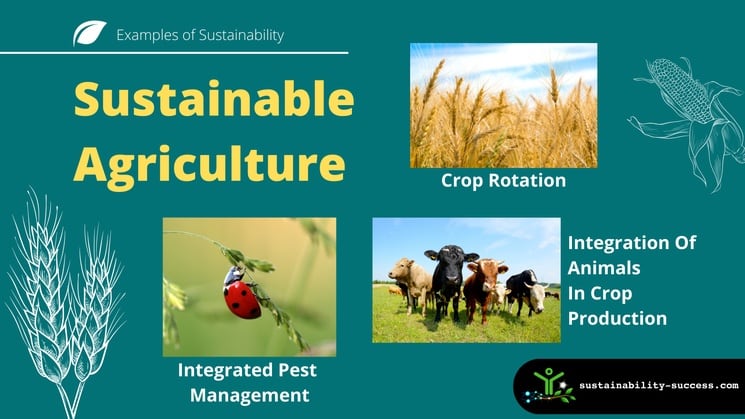
Sustainable agriculture means taking care of the natural resources, ecosystems, and biodiversity that the farms rely upon to produce food.
This involves things such as promoting biodiversity and healthy soil, reducing pollution to the minimum, and managing water consumption appropriately.
The fundamental idea to achieve this is to manage the farm as an actual ecosystem: also known as agroecology.
Following this fundamental concept, we can find some examples of sustainable business practices aimed at improving sustainability in agriculture, such as:
- Integration of animals in crop production: in natural ecosystems, animals and vegetation are coexisting together with mutual benefits. The animals get fed while the plants get fertilized. This contributes to naturally enriching and fertilizing the soil. On the other hand, in traditional industrial farming, the livestock is generally kept far away from the fields where the crops are grown. According to recent studies, smart integration of livestock and crop production can contribute to improving the efficiency of the farms, making them more sustainable and profitable.
- Crop rotation: this can involve both growing multiple crops at the same time on the same soil (intercropping) and annual crop rotation. As a result of rotating crops, a reduced quantity of pests, and the soil are also replenished with nutrients. These techniques are very old as they were already used well before the start of industrial agriculture, which instead relies on the massive use of pesticides and fertilizers.
- Integrated pest management (IPM): this can be achieved in natural ways that don’t involve the use of polluting pesticides. One way to do this is for example by introducing into the crops ecosystem animal species that are predators of the pests that can affect a specific colture.
Another way to promote sustainable agriculture is to start a garden in your backyard. If you decide to start a garden, you should first learn about pests and other animals that may affect your plants. For example, squirrels can eat tomatoes if you don’t keep them out of your garden!
4. Renewable Energy

Renewable energy is probably one of the first things we think about when looking for examples of green technology. Renewable energy includes mainly:
- Solar energy – The energy of the sun can be harvested in many ways. The most popular of those are solar panels. Solar panels can be of 2 different categories: thermal to produce hot water or photovoltaic to produce electricity. Those could be installed on the roof of your house, as well as on boats and RVs (for which you will also need solar batteries).
- Wind energy – The wind is a renewable energy source that doesn’t cause carbon emissions, is plentiful and readily available. Wind turbines are the green technology used to sustainably convert the wind’s power into electricity and they can also be installed offshore, without occupying any land and out of sight. If you want to know more, here are the pros and cons of wind energy.
- Hydropower – This was one of the first renewable energy sources to be harvested to produce electricity. There are many hydropower pros and cons, but this green energy source is especially interesting because it can run 24/7. Instead, other renewable energy sources like wind and solar, while giving many benefits to the environment, are intermittent by their own nature.
- Geothermal Energy – Water and/or steam are naturally heated up under the Earth’s crust. Then they arrive on the Earth’s surface carrying the geothermal energy accumulated underground. This hot vapor or water can then be used to produce clean energy.
- Biogas And Biofuels – These are eco-friendly methane or fuel produced from natural and renewable sources. Biogas in particular can be produced from organic waste and is a great example of sustainability.
Renewable and clean energy represents a fundamental step toward sustainable development. Helping to reduce CO2 emissions and the use of non-renewable resources.
5. Sustainable mobility
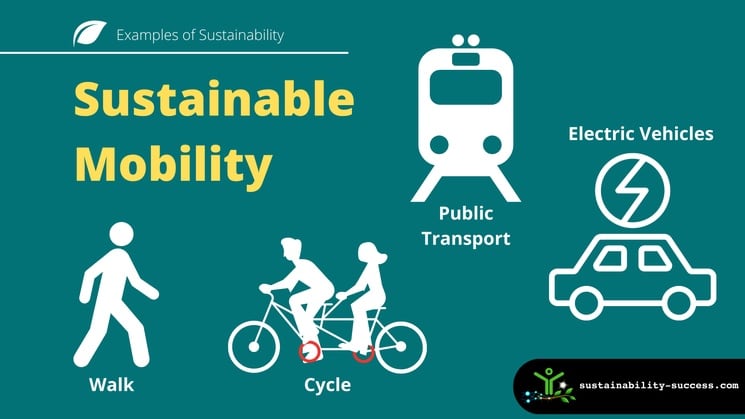
Sustainable mobility aims at improving energy efficiency and reducing the greenhouse gas emissions generated to move goods and people around.
This involves also promoting alternative means of travel by inviting people to walk and cycle more, increasing the use of public transport as an alternative to private cars.
The transport sector is accounting for about 21% of global emissions, making this one very important area of action to achieve sustainable development.
Road transport is responsible for about three-quarters of the worldwide emissions related to the travel sector. About 45% of those emissions are due to cars and buses, for a total of about 7% (in absolute terms) of the worldwide greenhouse gas emissions.
Let’s look more in detail at some examples of what we can do to be more sustainable in our mobility:
- Walk – If you have to go somewhere within 2km distance, plan for a nice walk to get there instead of using a private car. Walking more will not only reduce your ecological footprint but is also very good for your health and wellbeing, by reducing stress, improving heart function, and breathing some fresh air.
- Use A Bicycle – Cycling is another great way to move sustainably. It is increasing the range you can reach by using only your physical energy. Using a bicycle you can easily reach any destination within 8-10 km in an urban environment and, again, it is also good for your health. To keep the citizens safe while riding their bicycles and to make it more convenient, governments need to create the necessary infrastructure, like dedicated cycling paths or preferential lanes for bicycles.
- Use Public Transport – If you can’t walk or cycle you can always opt to use public transport. This, compared to using a private car, will reduce the resources needed to bring you to your destination. To encourage the citizens to use more public transport local authorities and governments need to dedicate the right amount of resources to the sector, making it more convenient to use.
- Hybrid and Electric Vehicles – They have the potential to help reduce emissions and the overall environmental footprint of the transport sector.
6. Cardboard Recycling

Recycling is important and has many benefits, this is a fundamental step in the implementation of the circular economy and sustainability. Cardboard recycling is among the examples of sustainability that are already giving many benefits to us and the planet.
Cardboard recycling helps reduce packaging waste and allows for the recovery of this valuable material. This is by far the most popular packaging material, used to safely ship more than 90% of the goods in the United States. That’s why cardboard recycling is so important to reach sustainable development.
Cardboard is a valuable material and recycling helps to dramatically reduce the number of trees cut to produce it.
The recycling process is supported by the value of the material itself because companies can profit from selling their cardboard waste to recycling centers.
Moreover, with baled cardboard, the profit made by recycling used packaging can be boosted by about 30%. This is because baled cardboard is easier to handle and takes up less space when kept in storage.
Cardboard recycling is a clear example of how a circular economy works and of its advantages for sustainability.
7. Green computing

Information technology (IT), in terms of electricity consumption, is responsible for about 1.4% of the CO2 emissions worldwide. Pursuing green computing (green IT) to reduce the emissions directly generated by this sector is very important.
However, some additional factors need to be considered when evaluating the overall sustainability of information technology:
- Device Manufacturing Methodology – Recycled materials and renewable energy should be preferred when possible.
- Hazardous Substances – Avoid using and/or releasing dangerous substances for the production of the device.
- Energy Efficiency Of The Device – Minimizing energy consumption has the largest impact on the emissions generated by the IT sector. The most important parameter to measure the energy efficiency is the number of flops per watt. But the effective energy consumption will finally depend on the type of application that will run on the device.
- Device Lifespan – A long lifespan helps reduce waste because the device will be used for a longer time.
- Rare Or Exotic Materials – Those are difficult to recycle and will be lost forever once the device goes out of service.
There are a lot of efforts to make IT more eco-friendly and those are the most important points we should consider when evaluating the sustainability of an electronic device by itself.
A lot of energy and resources could be saved if the device is energy efficient and sustainably manufactured.
From the user perspective instead, finding the right balance between having a long enough lifecycle and eventually upgrading to a new machine when the performance leap is large enough to justify replacing the old device.
Besides the sustainability considerations regarding the computing sector by itself, it is very important to note that those technologies are the backbone of Industry 4.0. As such, regardless of the energy consumption of the devices, they are in any case going to have a positive impact on sustainability by making manufacturing much more efficient.
8. Green Tourism

Green tourism is another interesting example of sustainable development.
Throughout the year 2018, it is estimated there were about 1.4 billion international tourist arrivals, just over a fifth of the world population. Tourism is huge, and its negative impact on the environment and the climate is huge as well.
These negative effects can include environmental destruction, the unethical treatment of wildlife and animals, damage to communities and their heritage, and the high amount of greenhouse gas emissions from air transport.
On the bright side, the growing awareness of environmental problems is leading to an increased interest in green tourism, sustainable tourism, ecotourism, and geotourism.
Green tourism has the aim of being environmentally friendly and reducing the many negative effects associated with travel.
This involves things like visiting natural, untouched areas in responsible, non-damaging ways, participating in protecting wildlife, getting to your destination with as little greenhouse gas emissions as possible, and avoiding tourist attractions that are harmful to nature or to society.
Sustainable tourism helps also to support the local communities by benefiting their economy, preserving their heritage, and improving local wellbeing.
There are many great sustainable tourism examples that you can consider for your eco-friendly holidays. Those include many eco-lodges, eco hotels, and resorts where you can travel more sustainably. This sector is also growing very rapidly, and there will be more and more options available as time goes by.
9. Sustainable Concrete
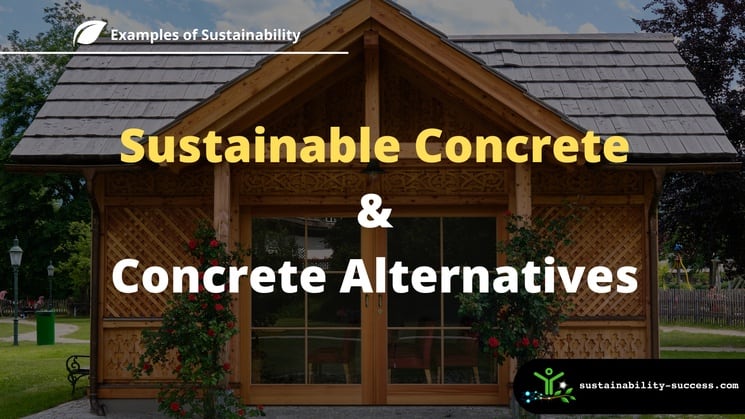
Concrete is by far humanity’s most widely used building material, and the second most used material on the earth behind water. Sadly, this immense level of production comes with severely negative effects on the environment.
For example, the production of cement alone creates an immense amount of carbon dioxide, accounting for about 8% of worldwide greenhouse gas emissions. Concrete production also requires large amounts of water.
For those reasons, switching to sustainable concrete or concrete alternatives is a very important example of sustainability.
Among the best alternatives to concrete available today we can find:
- Bamboo – It is very strong, yet flexible and light. Bamboo is also growing quickly and it represents an important sustainable construction material, especially in Asia.
- Wood – If managed properly, it is a renewable resource and it can be a good alternative to concrete.
- Use fibers made of recycled plastic to replace the steel mesh in the concrete. Thanks to this technology it is possible to reduce the emissions by about 90% compared to the use of a traditional steel mesh for concrete.
- Rammed earth – Is built using compacted soil or other materials from the ground. It is an ancient building technique that may have an important role in the modern world as well, as it generally has an extremely low environmental impact.
10. Efficient Lighting
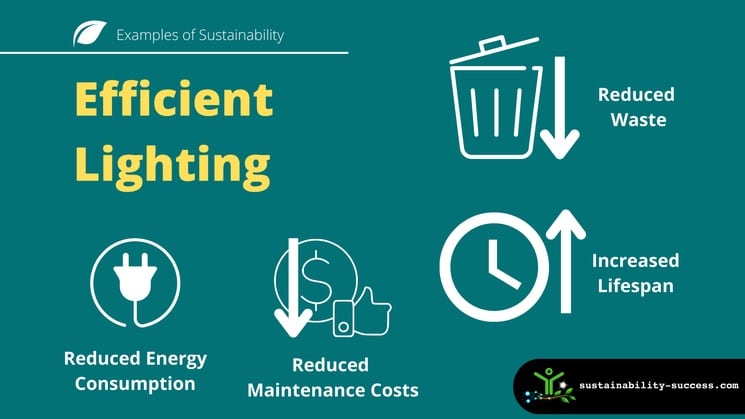
Lighting is responsible for about 15% of your home’s electricity consumption, for this reason, efficient lighting has become a good example of sustainable development.
In recent years efficient LED lighting has been gradually replacing traditional systems and became a good example of sustainable development.
The advantages of LEDs include:
- Reduced energy consumption by 85-95%
- Reduced maintenance costs
- Improved safety
- Life-span of over 30 years
- Reduced waste
For those reasons, it is no surprise that an investment in LED lights is simply paying off by itself and traditional light bulbs are gradually disappearing from the stores.
Conclusions
Sustainability requires, first of all, a shift in the business and government leaders’ mindset toward a long-term sustainable vision. Allowing for the preservation of the world’s resources and ecosystems for future generations.
This involves envisioning and then implementing complex strategies over the next decade or so while also taking care of the usual shorter-term challenges involving profit and loss.
In this article I reviewed 10 interesting examples of sustainable development:
- Sustainable manufacturing
- Sustainable Urban Design
- Sustainable Agriculture
- Renewable Energy
- Sustainable Mobility
- Cardboard Recycling
- Green Computing
- Green Tourism
- Sustainable Concrete
- Efficient Lighting
Those are just some of the available examples. However, each one of those sustainable future examples shows that sustainable development is not only possible but within our reach!

